Copyright and Fair Use: Balancing Innovation and Protection of Work
VerifiedAdded on 2022/09/01
|6
|1382
|14
Essay
AI Summary
This essay provides a comprehensive overview of copyright and fair use, delving into the historical context and legal frameworks surrounding intellectual property. It examines the initial focus of copyright on scientific inventions and the subsequent expansion to include literary and artistic works. The essay contrasts the propertarian approach, which grants extensive rights to copyright holders, with the democratic approach, which emphasizes fair use and public access. It explores the challenges posed by digital channels and social media, including the complexities of transformative purposes and copyright infringement. The essay discusses the four aspects of fair use law, the impact of copyright on society, and the importance of balancing the protection of creators' rights with the promotion of innovation and access to information. The essay also provides an analysis of the references that support the arguments.
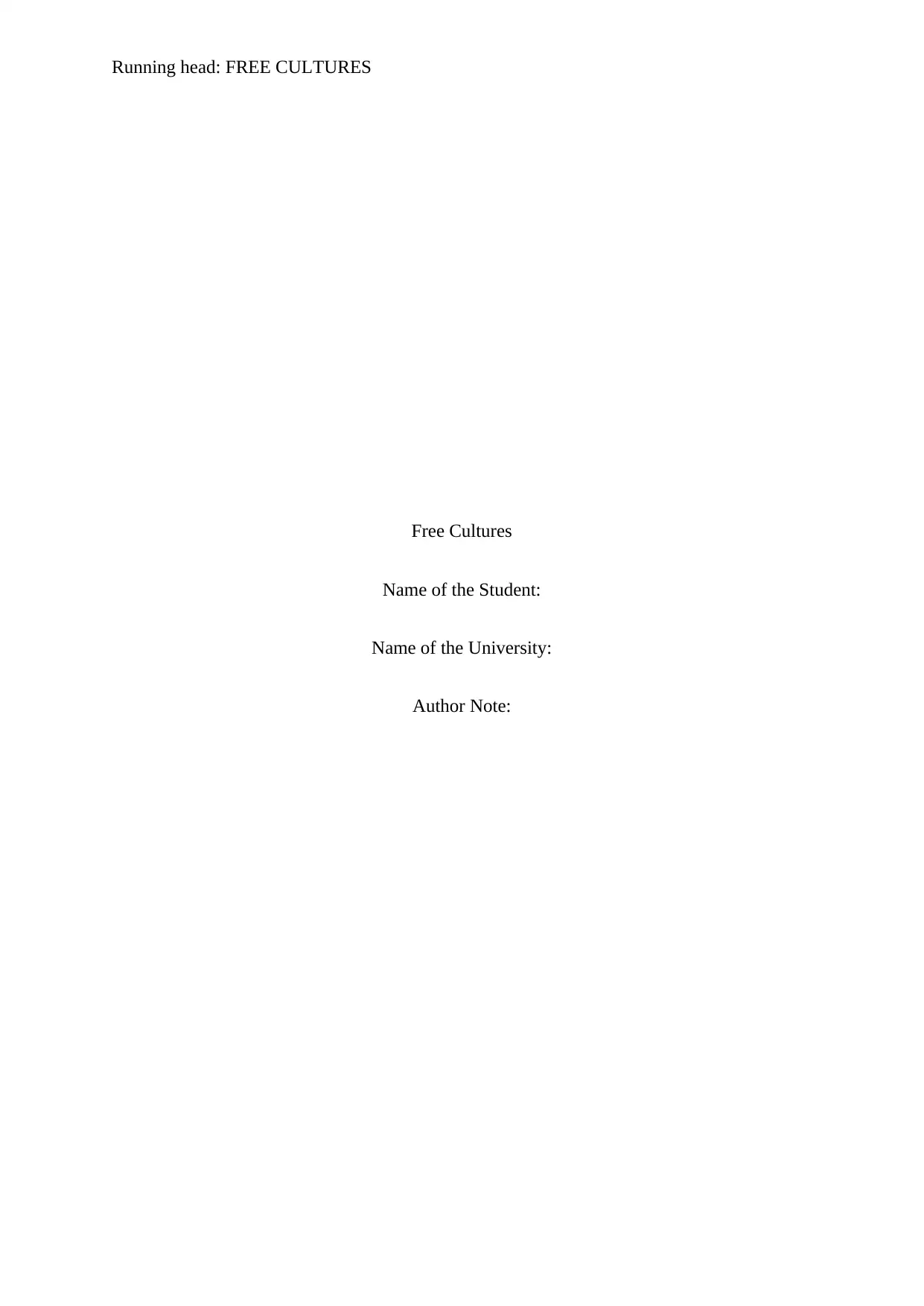
Running head: FREE CULTURES
Free Cultures
Name of the Student:
Name of the University:
Author Note:
Free Cultures
Name of the Student:
Name of the University:
Author Note:
Paraphrase This Document
Need a fresh take? Get an instant paraphrase of this document with our AI Paraphraser
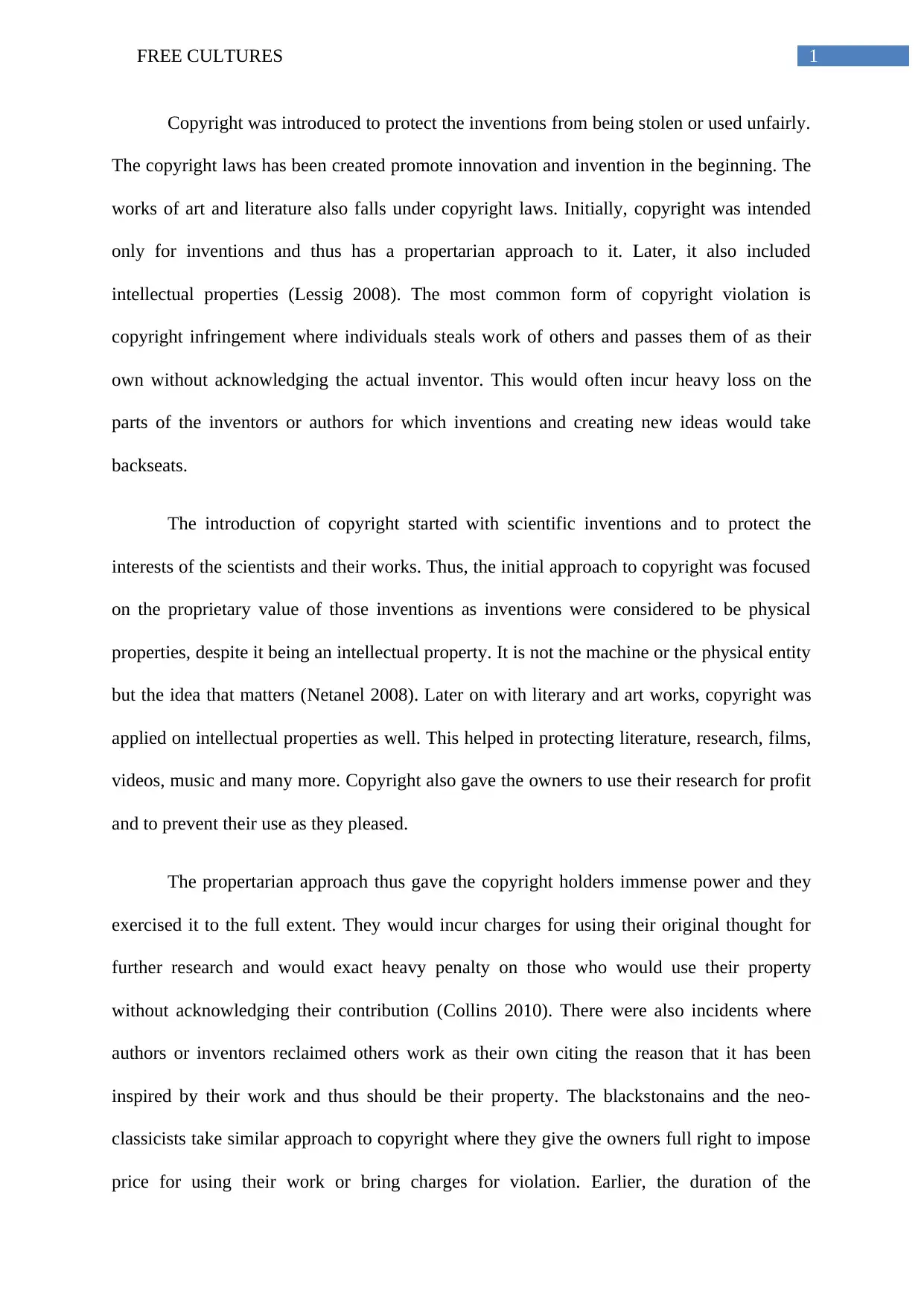
1FREE CULTURES
Copyright was introduced to protect the inventions from being stolen or used unfairly.
The copyright laws has been created promote innovation and invention in the beginning. The
works of art and literature also falls under copyright laws. Initially, copyright was intended
only for inventions and thus has a propertarian approach to it. Later, it also included
intellectual properties (Lessig 2008). The most common form of copyright violation is
copyright infringement where individuals steals work of others and passes them of as their
own without acknowledging the actual inventor. This would often incur heavy loss on the
parts of the inventors or authors for which inventions and creating new ideas would take
backseats.
The introduction of copyright started with scientific inventions and to protect the
interests of the scientists and their works. Thus, the initial approach to copyright was focused
on the proprietary value of those inventions as inventions were considered to be physical
properties, despite it being an intellectual property. It is not the machine or the physical entity
but the idea that matters (Netanel 2008). Later on with literary and art works, copyright was
applied on intellectual properties as well. This helped in protecting literature, research, films,
videos, music and many more. Copyright also gave the owners to use their research for profit
and to prevent their use as they pleased.
The propertarian approach thus gave the copyright holders immense power and they
exercised it to the full extent. They would incur charges for using their original thought for
further research and would exact heavy penalty on those who would use their property
without acknowledging their contribution (Collins 2010). There were also incidents where
authors or inventors reclaimed others work as their own citing the reason that it has been
inspired by their work and thus should be their property. The blackstonains and the neo-
classicists take similar approach to copyright where they give the owners full right to impose
price for using their work or bring charges for violation. Earlier, the duration of the
Copyright was introduced to protect the inventions from being stolen or used unfairly.
The copyright laws has been created promote innovation and invention in the beginning. The
works of art and literature also falls under copyright laws. Initially, copyright was intended
only for inventions and thus has a propertarian approach to it. Later, it also included
intellectual properties (Lessig 2008). The most common form of copyright violation is
copyright infringement where individuals steals work of others and passes them of as their
own without acknowledging the actual inventor. This would often incur heavy loss on the
parts of the inventors or authors for which inventions and creating new ideas would take
backseats.
The introduction of copyright started with scientific inventions and to protect the
interests of the scientists and their works. Thus, the initial approach to copyright was focused
on the proprietary value of those inventions as inventions were considered to be physical
properties, despite it being an intellectual property. It is not the machine or the physical entity
but the idea that matters (Netanel 2008). Later on with literary and art works, copyright was
applied on intellectual properties as well. This helped in protecting literature, research, films,
videos, music and many more. Copyright also gave the owners to use their research for profit
and to prevent their use as they pleased.
The propertarian approach thus gave the copyright holders immense power and they
exercised it to the full extent. They would incur charges for using their original thought for
further research and would exact heavy penalty on those who would use their property
without acknowledging their contribution (Collins 2010). There were also incidents where
authors or inventors reclaimed others work as their own citing the reason that it has been
inspired by their work and thus should be their property. The blackstonains and the neo-
classicists take similar approach to copyright where they give the owners full right to impose
price for using their work or bring charges for violation. Earlier, the duration of the
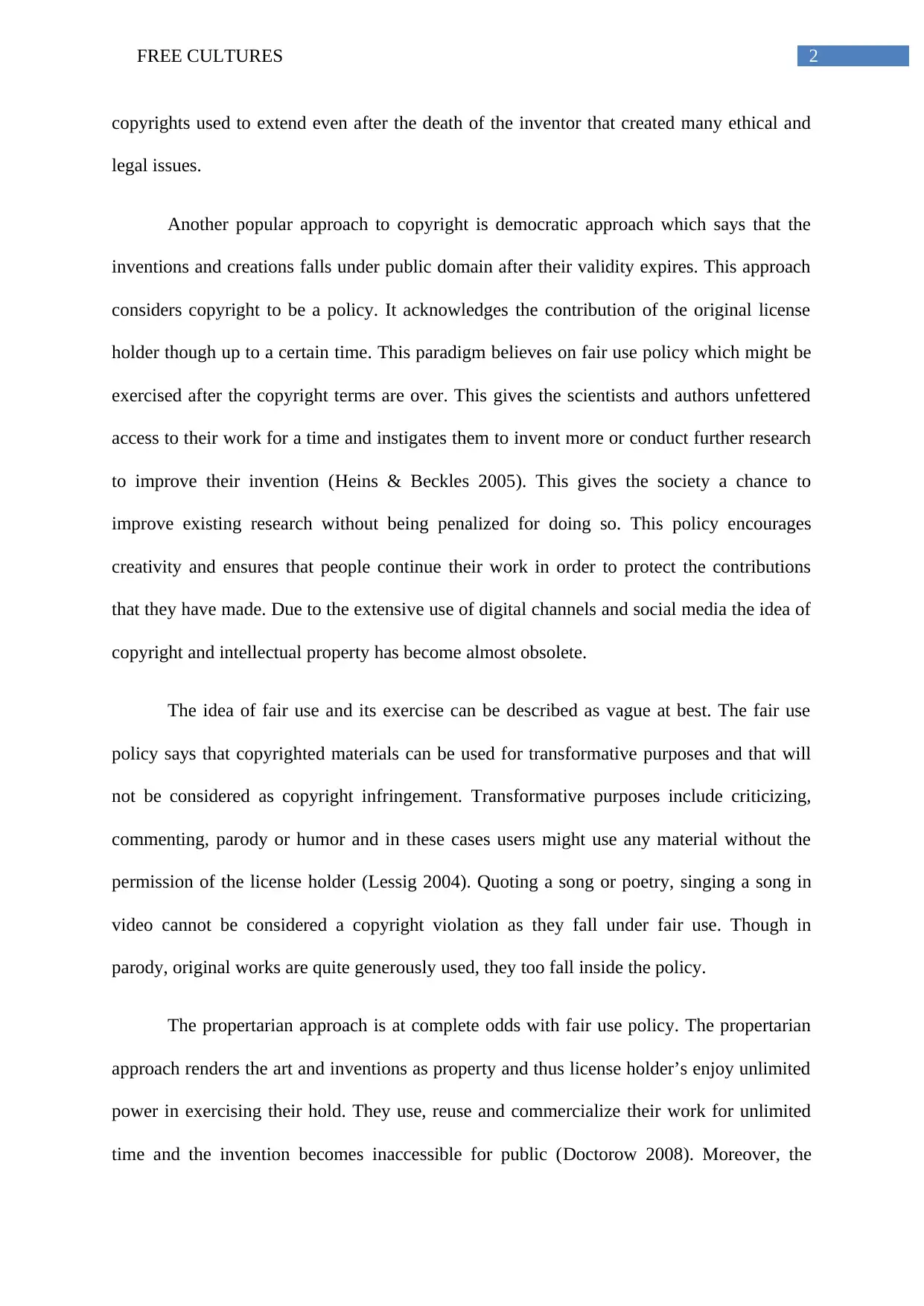
2FREE CULTURES
copyrights used to extend even after the death of the inventor that created many ethical and
legal issues.
Another popular approach to copyright is democratic approach which says that the
inventions and creations falls under public domain after their validity expires. This approach
considers copyright to be a policy. It acknowledges the contribution of the original license
holder though up to a certain time. This paradigm believes on fair use policy which might be
exercised after the copyright terms are over. This gives the scientists and authors unfettered
access to their work for a time and instigates them to invent more or conduct further research
to improve their invention (Heins & Beckles 2005). This gives the society a chance to
improve existing research without being penalized for doing so. This policy encourages
creativity and ensures that people continue their work in order to protect the contributions
that they have made. Due to the extensive use of digital channels and social media the idea of
copyright and intellectual property has become almost obsolete.
The idea of fair use and its exercise can be described as vague at best. The fair use
policy says that copyrighted materials can be used for transformative purposes and that will
not be considered as copyright infringement. Transformative purposes include criticizing,
commenting, parody or humor and in these cases users might use any material without the
permission of the license holder (Lessig 2004). Quoting a song or poetry, singing a song in
video cannot be considered a copyright violation as they fall under fair use. Though in
parody, original works are quite generously used, they too fall inside the policy.
The propertarian approach is at complete odds with fair use policy. The propertarian
approach renders the art and inventions as property and thus license holder’s enjoy unlimited
power in exercising their hold. They use, reuse and commercialize their work for unlimited
time and the invention becomes inaccessible for public (Doctorow 2008). Moreover, the
copyrights used to extend even after the death of the inventor that created many ethical and
legal issues.
Another popular approach to copyright is democratic approach which says that the
inventions and creations falls under public domain after their validity expires. This approach
considers copyright to be a policy. It acknowledges the contribution of the original license
holder though up to a certain time. This paradigm believes on fair use policy which might be
exercised after the copyright terms are over. This gives the scientists and authors unfettered
access to their work for a time and instigates them to invent more or conduct further research
to improve their invention (Heins & Beckles 2005). This gives the society a chance to
improve existing research without being penalized for doing so. This policy encourages
creativity and ensures that people continue their work in order to protect the contributions
that they have made. Due to the extensive use of digital channels and social media the idea of
copyright and intellectual property has become almost obsolete.
The idea of fair use and its exercise can be described as vague at best. The fair use
policy says that copyrighted materials can be used for transformative purposes and that will
not be considered as copyright infringement. Transformative purposes include criticizing,
commenting, parody or humor and in these cases users might use any material without the
permission of the license holder (Lessig 2004). Quoting a song or poetry, singing a song in
video cannot be considered a copyright violation as they fall under fair use. Though in
parody, original works are quite generously used, they too fall inside the policy.
The propertarian approach is at complete odds with fair use policy. The propertarian
approach renders the art and inventions as property and thus license holder’s enjoy unlimited
power in exercising their hold. They use, reuse and commercialize their work for unlimited
time and the invention becomes inaccessible for public (Doctorow 2008). Moreover, the
⊘ This is a preview!⊘
Do you want full access?
Subscribe today to unlock all pages.

Trusted by 1+ million students worldwide
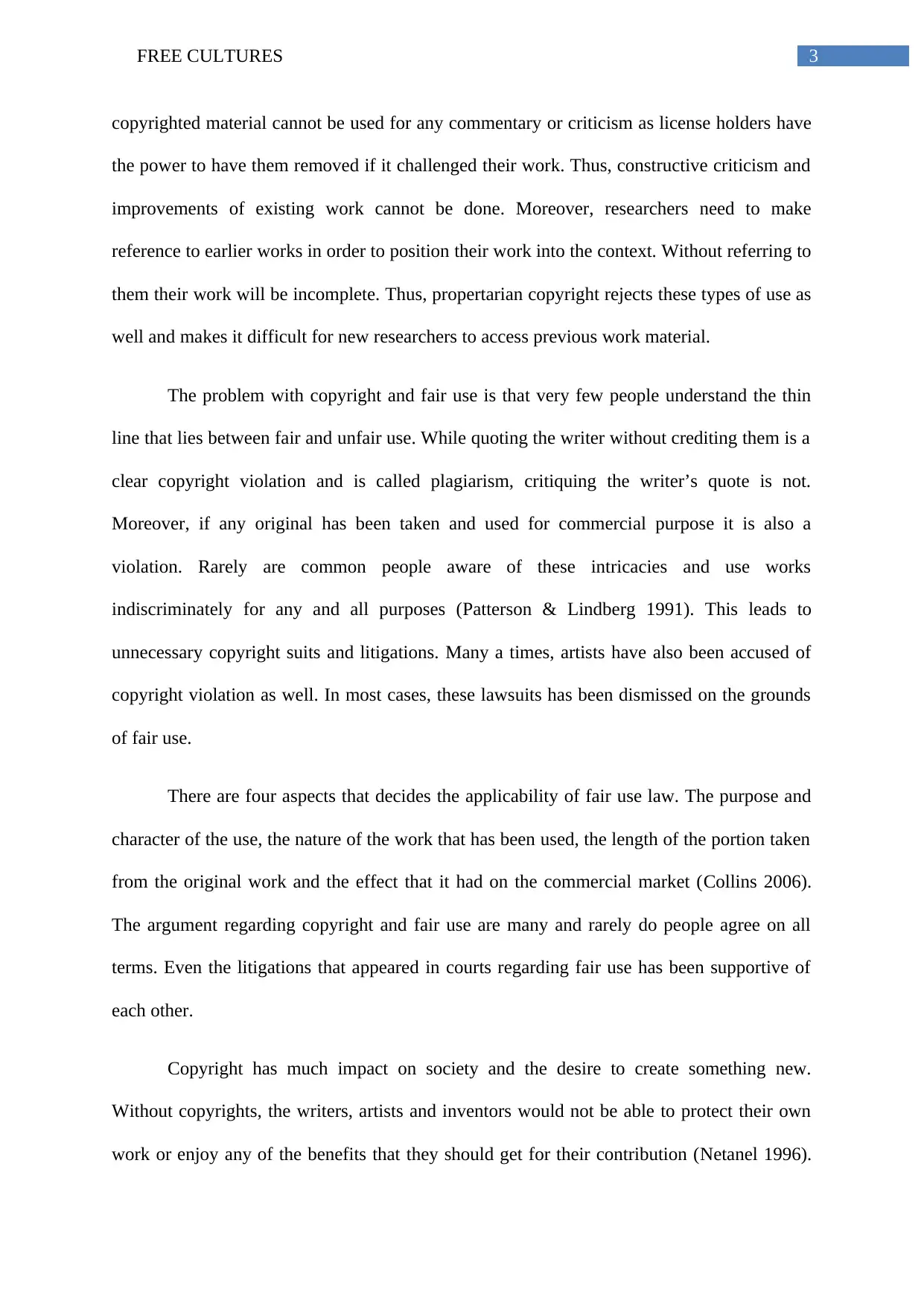
3FREE CULTURES
copyrighted material cannot be used for any commentary or criticism as license holders have
the power to have them removed if it challenged their work. Thus, constructive criticism and
improvements of existing work cannot be done. Moreover, researchers need to make
reference to earlier works in order to position their work into the context. Without referring to
them their work will be incomplete. Thus, propertarian copyright rejects these types of use as
well and makes it difficult for new researchers to access previous work material.
The problem with copyright and fair use is that very few people understand the thin
line that lies between fair and unfair use. While quoting the writer without crediting them is a
clear copyright violation and is called plagiarism, critiquing the writer’s quote is not.
Moreover, if any original has been taken and used for commercial purpose it is also a
violation. Rarely are common people aware of these intricacies and use works
indiscriminately for any and all purposes (Patterson & Lindberg 1991). This leads to
unnecessary copyright suits and litigations. Many a times, artists have also been accused of
copyright violation as well. In most cases, these lawsuits has been dismissed on the grounds
of fair use.
There are four aspects that decides the applicability of fair use law. The purpose and
character of the use, the nature of the work that has been used, the length of the portion taken
from the original work and the effect that it had on the commercial market (Collins 2006).
The argument regarding copyright and fair use are many and rarely do people agree on all
terms. Even the litigations that appeared in courts regarding fair use has been supportive of
each other.
Copyright has much impact on society and the desire to create something new.
Without copyrights, the writers, artists and inventors would not be able to protect their own
work or enjoy any of the benefits that they should get for their contribution (Netanel 1996).
copyrighted material cannot be used for any commentary or criticism as license holders have
the power to have them removed if it challenged their work. Thus, constructive criticism and
improvements of existing work cannot be done. Moreover, researchers need to make
reference to earlier works in order to position their work into the context. Without referring to
them their work will be incomplete. Thus, propertarian copyright rejects these types of use as
well and makes it difficult for new researchers to access previous work material.
The problem with copyright and fair use is that very few people understand the thin
line that lies between fair and unfair use. While quoting the writer without crediting them is a
clear copyright violation and is called plagiarism, critiquing the writer’s quote is not.
Moreover, if any original has been taken and used for commercial purpose it is also a
violation. Rarely are common people aware of these intricacies and use works
indiscriminately for any and all purposes (Patterson & Lindberg 1991). This leads to
unnecessary copyright suits and litigations. Many a times, artists have also been accused of
copyright violation as well. In most cases, these lawsuits has been dismissed on the grounds
of fair use.
There are four aspects that decides the applicability of fair use law. The purpose and
character of the use, the nature of the work that has been used, the length of the portion taken
from the original work and the effect that it had on the commercial market (Collins 2006).
The argument regarding copyright and fair use are many and rarely do people agree on all
terms. Even the litigations that appeared in courts regarding fair use has been supportive of
each other.
Copyright has much impact on society and the desire to create something new.
Without copyrights, the writers, artists and inventors would not be able to protect their own
work or enjoy any of the benefits that they should get for their contribution (Netanel 1996).
Paraphrase This Document
Need a fresh take? Get an instant paraphrase of this document with our AI Paraphraser
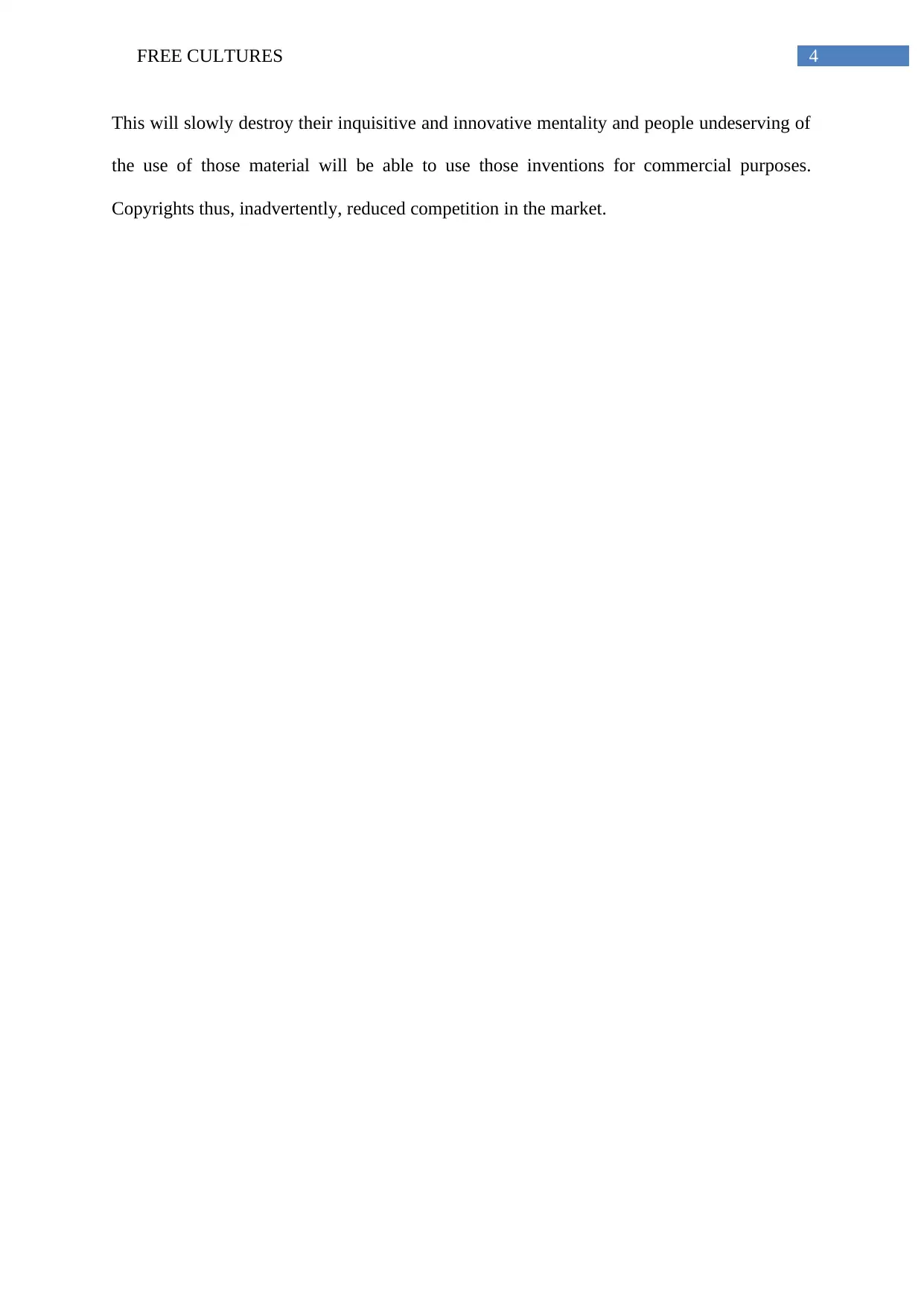
4FREE CULTURES
This will slowly destroy their inquisitive and innovative mentality and people undeserving of
the use of those material will be able to use those inventions for commercial purposes.
Copyrights thus, inadvertently, reduced competition in the market.
This will slowly destroy their inquisitive and innovative mentality and people undeserving of
the use of those material will be able to use those inventions for commercial purposes.
Copyrights thus, inadvertently, reduced competition in the market.
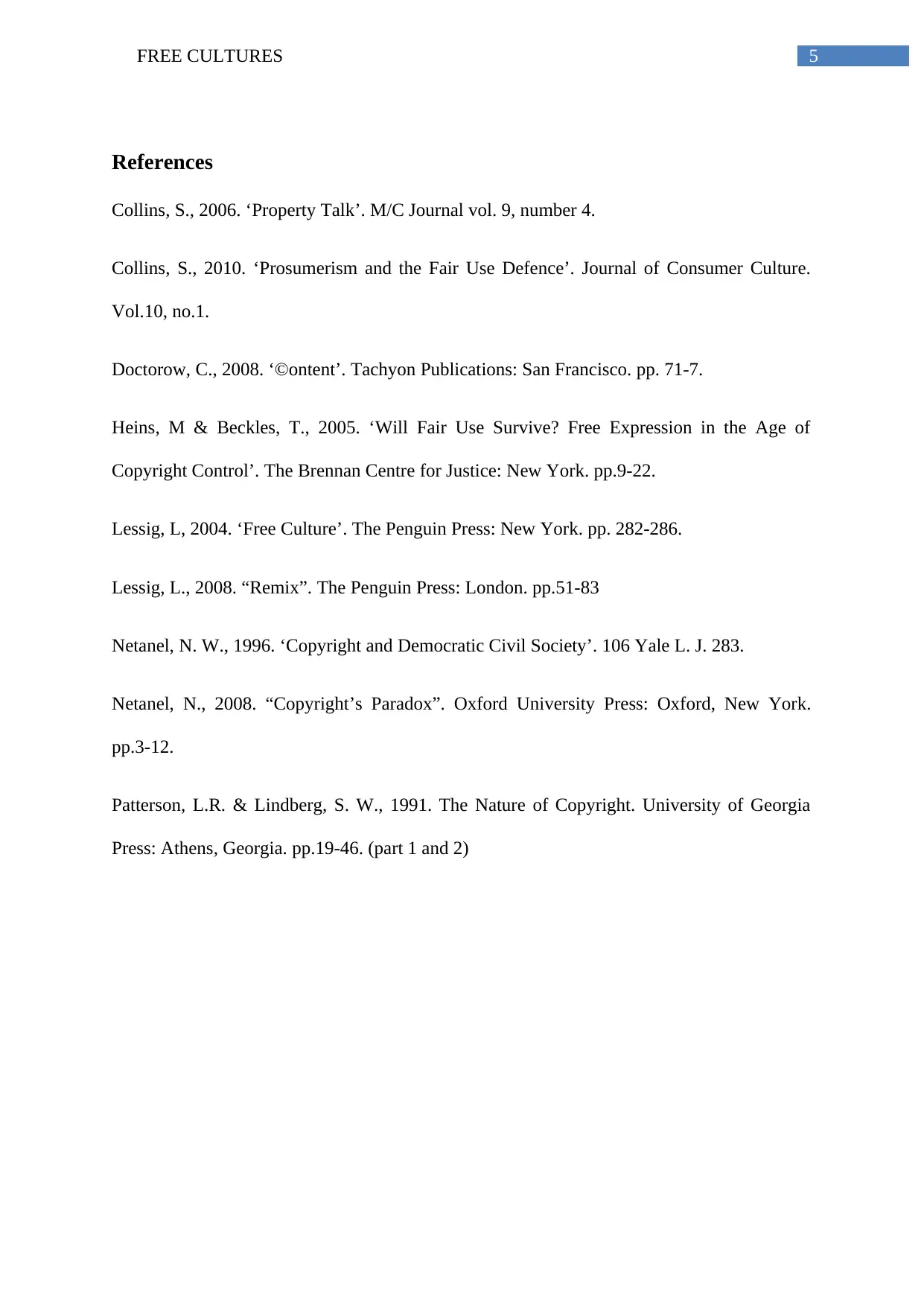
5FREE CULTURES
References
Collins, S., 2006. ‘Property Talk’. M/C Journal vol. 9, number 4.
Collins, S., 2010. ‘Prosumerism and the Fair Use Defence’. Journal of Consumer Culture.
Vol.10, no.1.
Doctorow, C., 2008. ‘©ontent’. Tachyon Publications: San Francisco. pp. 71-7.
Heins, M & Beckles, T., 2005. ‘Will Fair Use Survive? Free Expression in the Age of
Copyright Control’. The Brennan Centre for Justice: New York. pp.9-22.
Lessig, L, 2004. ‘Free Culture’. The Penguin Press: New York. pp. 282-286.
Lessig, L., 2008. “Remix”. The Penguin Press: London. pp.51-83
Netanel, N. W., 1996. ‘Copyright and Democratic Civil Society’. 106 Yale L. J. 283.
Netanel, N., 2008. “Copyright’s Paradox”. Oxford University Press: Oxford, New York.
pp.3-12.
Patterson, L.R. & Lindberg, S. W., 1991. The Nature of Copyright. University of Georgia
Press: Athens, Georgia. pp.19-46. (part 1 and 2)
References
Collins, S., 2006. ‘Property Talk’. M/C Journal vol. 9, number 4.
Collins, S., 2010. ‘Prosumerism and the Fair Use Defence’. Journal of Consumer Culture.
Vol.10, no.1.
Doctorow, C., 2008. ‘©ontent’. Tachyon Publications: San Francisco. pp. 71-7.
Heins, M & Beckles, T., 2005. ‘Will Fair Use Survive? Free Expression in the Age of
Copyright Control’. The Brennan Centre for Justice: New York. pp.9-22.
Lessig, L, 2004. ‘Free Culture’. The Penguin Press: New York. pp. 282-286.
Lessig, L., 2008. “Remix”. The Penguin Press: London. pp.51-83
Netanel, N. W., 1996. ‘Copyright and Democratic Civil Society’. 106 Yale L. J. 283.
Netanel, N., 2008. “Copyright’s Paradox”. Oxford University Press: Oxford, New York.
pp.3-12.
Patterson, L.R. & Lindberg, S. W., 1991. The Nature of Copyright. University of Georgia
Press: Athens, Georgia. pp.19-46. (part 1 and 2)
⊘ This is a preview!⊘
Do you want full access?
Subscribe today to unlock all pages.

Trusted by 1+ million students worldwide
1 out of 6
Related Documents
Your All-in-One AI-Powered Toolkit for Academic Success.
+13062052269
info@desklib.com
Available 24*7 on WhatsApp / Email
![[object Object]](/_next/static/media/star-bottom.7253800d.svg)
Unlock your academic potential
Copyright © 2020–2025 A2Z Services. All Rights Reserved. Developed and managed by ZUCOL.



